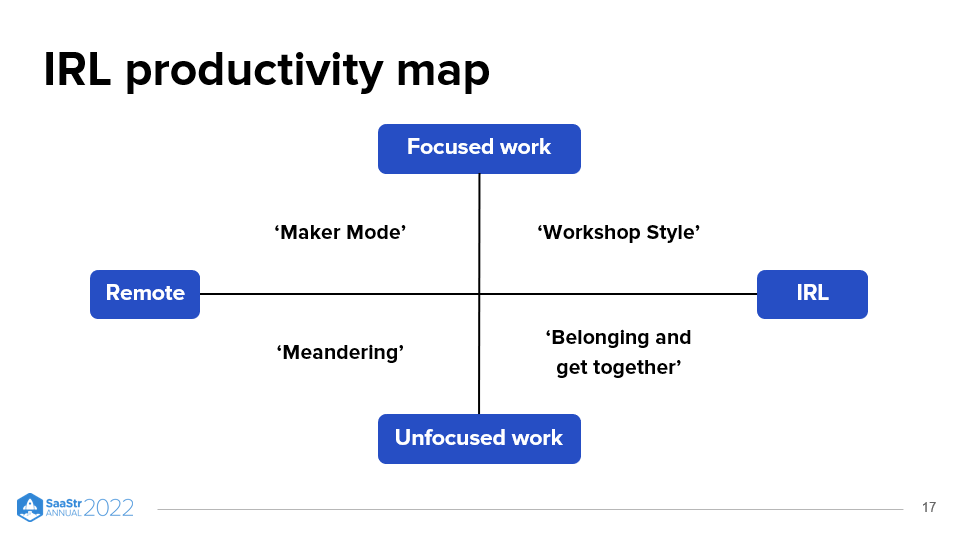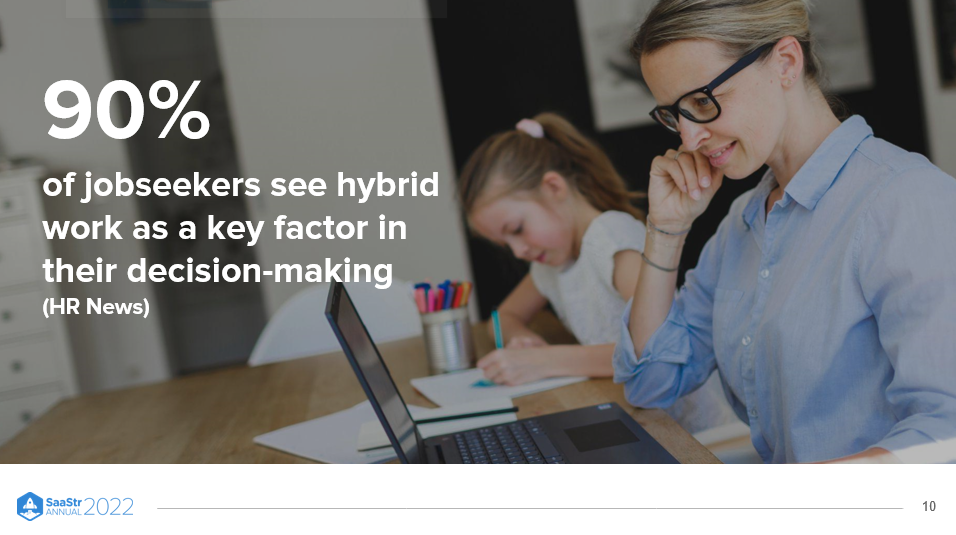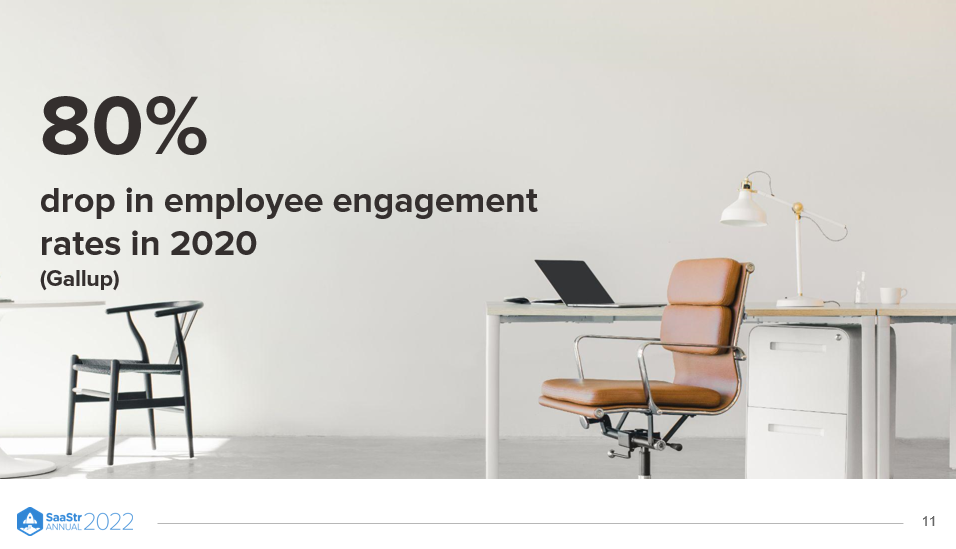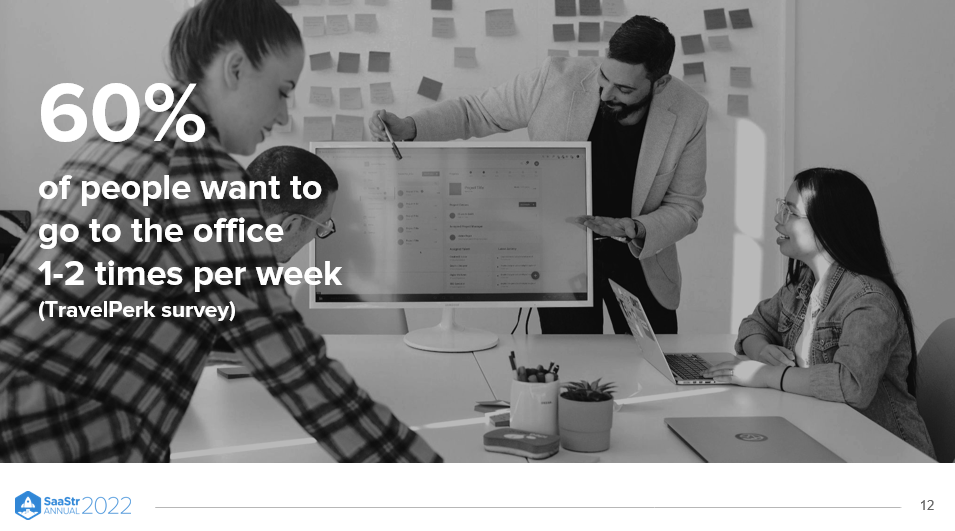The way we work has changed. A rapid rise in remote work has led to broader talent pools and hiring options for companies and greater flexibility for employees. With office life forever changed, how can companies use in-person face time most effectively?
In this presentation, TravelPerk COO Huw Slater and CPO Sally Sourbron share actionable strategies for incorporating IRL into company life to drive engagement and boost your bottom line.

Defining IRL: Purpose-Led Experiences Through Moments That Matter
IRL (in real life) has historically been associated with the gaming and VR industries. IRL 2.0 can be defined as “When you choose to meet colleagues, customers, and partners in real life because the value of meeting in person goes beyond the digital workspace.”
The concept of IRL has shifted from its roots in gaming because the way we work is different. The digital revolution and the pandemic accelerated the rise of remote and hybrid offices. As Sourbron says, “The way in which work gets done has fundamentally shifted, and we’re actually still designing and thinking around what that looks like, whether you are a hybrid organization, whether you’re a digital-first organization, you are thinking around, how do we collaborate as employees? How do we connect to our company’s strategy? So all of this is being redefined.”
Even as companies adapt to the new expectation of remote and hybrid workplaces, it’s still important to consider IRL strategies that can serve your employees and bottom line. Sourbron continues, “What we believe is that there needs to be an “in-real-life” strategy in any organization to create purpose-led experiences through moments that matter.”

How IRL Drives Better Business
IRL goes beyond company culture. If you get your IRL strategy right, you can support your organization in how it attracts and retains talent, drives creativity and productivity, and how it ultimately impacts your bottom line.
IRL Helps Attract Talent and Reduce Employee Churn
While it is true that employees like remote work, they don’t necessarily need it all the time. 90% of job seekers see hybrid work as a critical factor in their decision-making, and because it’s a competitive landscape for hiring, it’s vital that companies understand what workers are looking for in a future workplace. This means getting the hybrid strategy right.
Part of what makes IRL so valuable is the way it can influence engagement. There was an 80% drop in employee engagement rates in 2020. Sourbron emphasizes, “Engagement is critical in an organization. Employees want to have that connectivity.”
According to a TravelPerk survey, 60% of people prefer to visit the office one to two times per week, and 79% of employees want to get back to company events to meet colleagues. So by introducing IRL effectively, you may be able to attract quality employees and avoid the cost of attrition.

IRL Helps Drive Creativity and Boost Productivity
Before creating a hybrid strategy, it’s important to remember to be mindful of why you’re asking employees to come into the office. Slater shares that creating arbitrary in-office rules won’t yield the productivity or engagement results you may hope for: I’ll tell you what doesn’t drive productivity and creativity is a bums-on-seats, in-real-life strategy. Nobody wants to be told categorically, ‘you have to be here, sit down’ –– it’s a control process.”
Instead, when you think about when and whether to have employees come to the office, think about how the IRL element serves their role, the type of work, project, and purpose. “It’s a tool, not a rule –– coming to the office,” Slater says.
So, how exactly does IRL boost creativity and productivity? It’s helpful to examine some data:
- 74% of GenZ employees work most effectively when they have face time with their co-workers.
- 20% more ideas are generated through IRL meetings than through Zoom.
- 12% creativity increases a company’s growth by 12%.
So by creating relevant, purposeful, and project-appropriate IRL moments, you can build an inspired, more productive company that better drives revenue.

How to Build Your Own IRL Strategy
- Be Transparent. This goes back to the step of attracting talent. Candidates want to know what hybrid means. Be upfront right away and stick to your strategy.
- Give Employees a Voice. This is not necessarily about consensus-building but allows everyone to reflect on how to bring their best to work.
- Set IRL Guidelines. Define a social contract between a manager and an employee and with teams. This helps everyone understand how to collaborate and work together and set expectations.
- Organize Purpose-Led Experiences. Even fully remote companies like to bring their companies together on occasion. Think through the purpose of the gathering.
- Allocate IRL Spaces. Re-imagine the workspace and consider how the environment will impact your employee experience

Key Takeaways
- The right IRL approach will help you attract top talent and reduce attrition.
- By implementing a strong IRL strategy, you can increase productivity.
- Be transparent and give employees a voice when building your IRL plan.

